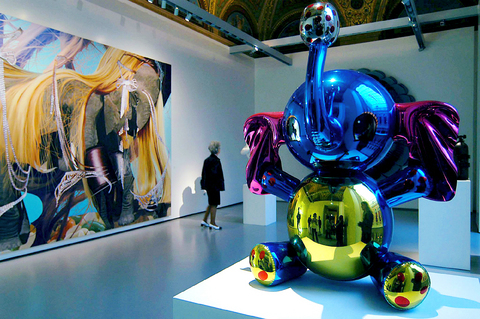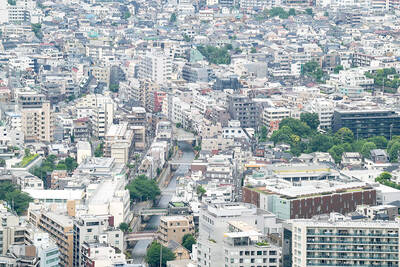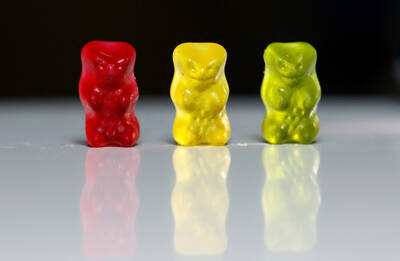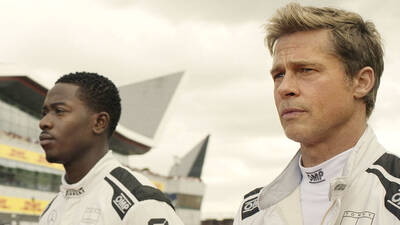For a billionaire looking for somewhere special to display his contemporary-art collection, the venerable Palazzo Grassi on Venice's Grand Canal is not bad for a second best.
True, Francois Pinault, the French owner of a myriad department stores as well as Christie's, Gucci and Yves Saint Laurent, had originally planned to build his own US$195 million museum, designed by Tadao Ando, on an island in the Seine southwest of Paris. But, last May, after five years of wrestling with red tape, he abandoned the project in frustration.
"Eternity is for art, not for projects that aim to serve it," he noted at the time.

PHOTOS: AGENCIES
So it is in Venice that the publicity-shy mogul is showing part of his vast art collection for the first time. And up to now, even few people in the art world knew what the collection included.
For this first exhibition of some 200 of his 2,500 artworks, the likes of Picasso, Miro and Picabia have been omitted. Instead, Pinault has chosen to focus on crucial artists of the last half-century, from Mark Rothko, Donald Judd, Gerhard Richter and Lucio Fontana to Richard Serra, Bruce Nauman, Cindy Sherman, Jeff Koons and Damien Hirst.
Few museums could offer such an overview. And, inevitably, the show has whetted the appetite of contem-porary-art lovers to discover the rest of his collection.

For Venice, it is no less a coup. This city may be better known for its Titians and Tintorettos, but it is also home to the Peggy Guggenheim Collection of modern art and the high-profile Venice Biennale of contemporary art. In fact, Mayor Massimo Cacciari would dearly like to see the entire Pinault collection installed here permanently.
Pinault, 69, has other plans. After collecting art for the last 30 years, he noted in the show's catalog, "the desire to possess -- born at the moment I first came in contact with art -- has been transformed into a profound need to share." Thus, his current idea is to hold exhibitions of different facets of his collection at a "network" of sites around Europe.
Still, the 18th-century Palazzo Grassi is a good place to start. Over the last two decades, under Fiat's ownership, it has won plaudits for organizing major exhibitions, in many cases tackling broad artistic and historical themes like the Celts, the Etruscans, the Maya and the Greeks. Visitors to Venice have come to expect quality shows here.

After Pinault acquired the building last year, he asked Ando to renovate it. Jean-Jacques Aillagon, a former French culture minister who earlier headed the Georges Pompidou Center, is now director of the palazzo. And Alison Gingeras, a young adjunct curator at the Solomon R. Guggenheim Museum in New York, has organized the first show, Where Are We Going?, which runs through Oct. 1.
Already from the Grand Canal, change is announced by Your Wave Is, an illuminated filigree by Olafur Eliasson that covers the facade of the palace. Also outside are Koons' Balloon Dog (Magenta) and two bizarre figures by Takashi Murakami. And visible through the building's main doors is Koons' large Hanging Heart, a newly completed red heart with golden bows that weighs no less than 2 tons.
Two other unusual works complete the introduction to the show. Carl Andre's 37th Piece of Work covers the courtyard with 1,296 metal plates of different colors and materials, while Piotr Uklanski's Untitled (Monsieur Francois Pinault) comprises a color photograph of a scanned image of the collector's head, in effect a skull to which the artist has added crossbones.
"It's a sort of vanity, a memento mori," Pinault said an interview with Paris-Match, adding drolly: "It's one of the possible answers to Where Are We Going?"
The rest of the exhibition fills two floors of the palazzo, where Ando has created self-contained spaces for individual artists and for group displays. And while some rooms are small, their windows face the courtyard or the canal, giving, for instance, three large Rothko oils ample breathing space.
The third floor, which dwells on Minimalism, gives its front gallery to six fine Judd sculptures, which look very much at home. Cy Twombly, Robert Ryman, Dan Flavin and Brice Marden also have their own rooms and, from Pinault's large collection of Arte Povera, there are works by Mario Merz, Jannis Kounellis, Pier Paulo Calzolari, Giuseppe Penone and Michelangelo Pistoletto.
The front gallery of the second floor is devoted to the eclectic art of Hirst, including two of his sliced cows preserved in formaldehyde, a steel cabinet lined with colored pills called Infinity, and The Fragile Truth, shelves covered by boxes of medicine. Gingeras has borrowed the show's title from Hirst's cabinet with animal skeletons, called Where Are We Going? Where Do We Come From? Is There A Reason?
Also presented alone are Koons and Sherman (with disturbing photographs of the genitalia of strange mannequins), while Mike Kelley, Paul McCarthy and Charles Ray confirm Pinault's interest in American art. More unexpected, though, is Maurizio Cattelan's Him, a schoolboy-size figure kneeling and looking into the corner of a room: closer inspection reveals Him to be a miniature Adolf Hitler.
Pinault has explained that he likes to collect artists in depth, while occasionally selling isolated works to strengthen other parts of his collection. (In June, he sold Robert Rauschenberg's Rebus to the Museum of Modern Art in New York for around US$30 million.) But Gingeras noted that he was also continually "pushing toward things he doesn't know."
Clearly, it helps to be rich. In the catalog, Pinault recalls the first painting that "deeply affected" him: "I took the painting home with me." And, fascinated by a Mondrian, "I bought it." But now, since he has handed the reins of his corporate empire to his son, Francois-Henri, art consumes his life. "Living with artworks has led me to question myself more," he writes, "to avoid being a prisoner of my convictions, to break with the comfort of habit."
Aillagon, who is charged with planning the Palazzo Grassi's future shows, said they will reach outside Pinault's collection. This fall, for example, the palace will present Picasso and the Joie de Vivre, followed next year by an exhibition exploring creativity in 1967 and an Arte Povera show, which will rely on Pinault's holdings.
Every two years from 2008 through 2016, Aillagon is preparing major exhibitions addressing Europe's relations with the world through the ages, starting with Rome and the barbarians and continuing with Christianity and Islam and successively with Europe and the Americas, the Far East and Africa.

The canonical shot of an East Asian city is a night skyline studded with towering apartment and office buildings, bright with neon and plastic signage, a landscape of energy and modernity. Another classic image is the same city seen from above, in which identical apartment towers march across the city, spilling out over nearby geography, like stylized soldiers colonizing new territory in a board game. Densely populated dynamic conurbations of money, technological innovation and convenience, it is hard to see the cities of East Asia as what they truly are: necropolises. Why is this? The East Asian development model, with

Desperate dads meet in car parks to exchange packets; exhausted parents slip it into their kids’ drinks; families wait months for prescriptions buy it “off label.” But is it worth the risk? “The first time I gave him a gummy, I thought, ‘Oh my God, have I killed him?’ He just passed out in front of the TV. That never happens.” Jen remembers giving her son, David, six, melatonin to help him sleep. She got them from a friend, a pediatrician who gave them to her own child. “It was sort of hilarious. She had half a tub of gummies,

The wide-screen spectacle of Formula One gets a gleaming, rip-roaring workout in Joseph Kosinski’s F1, a fine-tuned machine of a movie that, in its most riveting racing scenes, approaches a kind of high-speed splendor. Kosinski, who last endeavored to put moviegoers in the seat of a fighter jet in Top Gun: Maverick, has moved to the open cockpits of Formula One with much the same affection, if not outright need, for speed. A lot of the same team is back. Jerry Bruckheimer produces. Ehren Kruger, a co-writer on Maverick, takes sole credit here. Hans Zimmer, a co-composer previously, supplies the thumping

There is an old British curse, “may you live in interesting times,” passed off as ancient Chinese wisdom to make it sound more exotic and profound. We are living in interesting times. From US President Donald Trump’s decision on American tariffs, to how the recalls will play out, to uncertainty about how events are evolving in China, we can do nothing more than wait with bated breath. At the cusp of potentially momentous change, it is a good time to take stock of the current state of Taiwan’s political parties. As things stand, all three major parties are struggling. For our examination of the